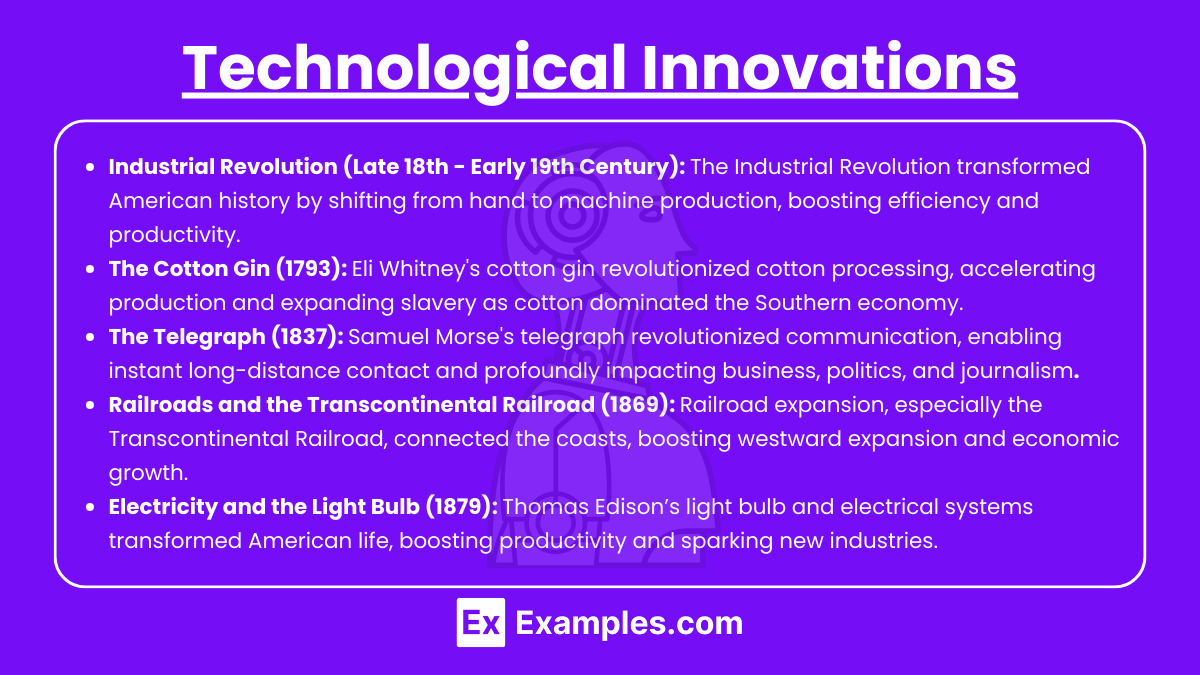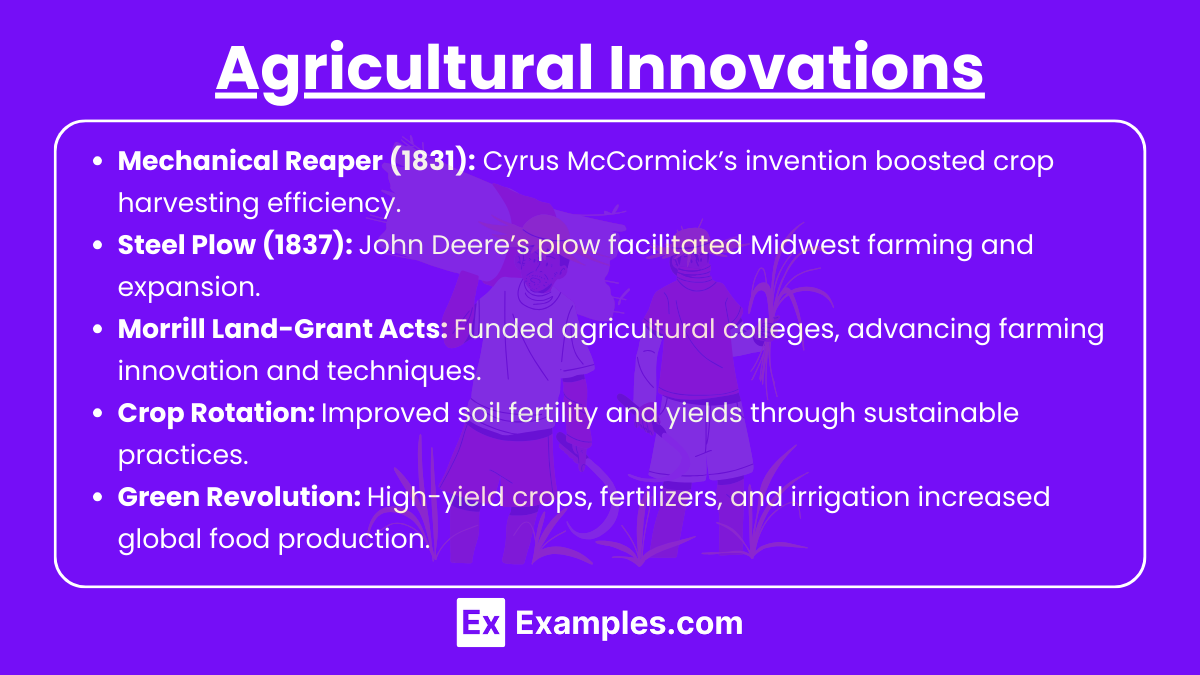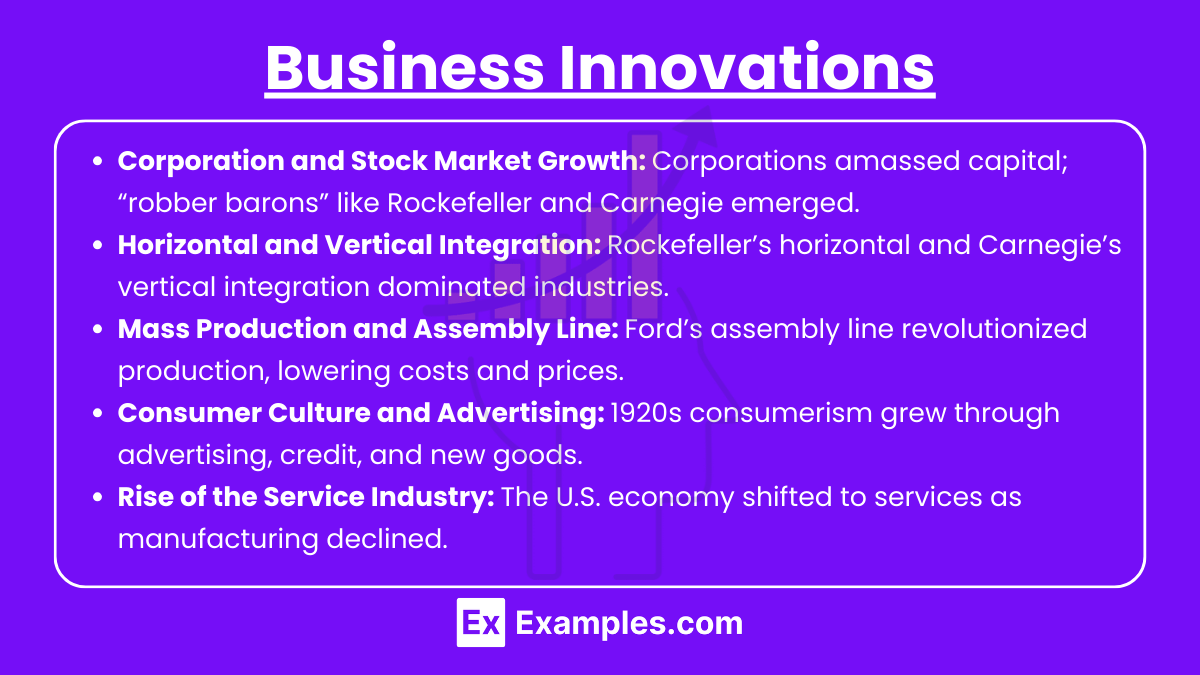In AP United States History, innovations in technology, agriculture, and business have played a crucial role in shaping the nation’s economic and social development. From the Industrial Revolution’s transformative impact on manufacturing to agricultural advancements like the cotton gin and the mechanical reaper, these innovations have driven productivity, expanded markets, and altered the American way of life. Additionally, business practices such as the rise of corporations and mass production techniques revolutionized industry, fueling economic growth and establishing the U.S. as a global power.
Learning Objectives
In studying innovations in technology, agriculture, and business for AP United States History, you will be expected to understand how these advancements contributed to economic growth and societal changes. The impact of key inventions and business practices on industrialization, agriculture, and consumer culture will be analyzed. You will also be able to evaluate how these innovations transformed American life, shaped regional economies, and influenced the United States’ emergence as a global economic power during the 19th and 20th centuries.
Technological Innovations

- Industrial Revolution (Late 18th – Early 19th Century): The Industrial Revolution marked a major turning point in American history, characterized by the shift from hand production methods to machine production, leading to increased efficiency and productivity.
- The Cotton Gin (1793): Invented by Eli Whitney, the cotton gin revolutionized the cotton industry by significantly speeding up the process of separating cotton fibers from seeds. This invention contributed to the expansion of slavery in the South as cotton became the dominant crop.
- The Telegraph (1837): Samuel Morse’s invention of the telegraph revolutionized communication, allowing for instant long-distance communication. This innovation had a profound impact on business, politics, and journalism, fostering national and international connections.
- Railroads and the Transcontinental Railroad (1869): The expansion of railroads facilitated the movement of goods, people, and ideas across the country. The completion of the Transcontinental Railroad connected the East and West coasts, promoting westward expansion and economic growth.
- Electricity and the Light Bulb (1879): Thomas Edison’s invention of the electric light bulb and the subsequent development of electrical power systems transformed American life and business, leading to increased productivity and the rise of new industries.
Agricultural Innovations

- The Mechanical Reaper (1831): Invented by Cyrus McCormick, the mechanical reaper increased the efficiency of harvesting crops, leading to increased agricultural productivity and the expansion of commercial farming in the Midwest.
- The Steel Plow (1837): John Deere’s steel plow made it easier to till the tough prairie soils of the Midwest, facilitating westward expansion and the development of the Great Plains as an agricultural center.
- Agricultural Colleges and the Morrill Land-Grant Acts (1862, 1890): These acts provided federal land to states to fund the establishment of agricultural and mechanical colleges. These institutions promoted agricultural innovation and research, leading to advances in farming techniques and crop production.
- Crop Rotation and Scientific Farming: The implementation of crop rotation and the development of new fertilizers and pesticides improved soil fertility and crop yields, leading to more sustainable farming practices.
- The Green Revolution (Mid-20th Century): A period of significant agricultural advancement characterized by the introduction of high-yield crops, chemical fertilizers, and modern irrigation techniques. These innovations increased food production globally, though they also raised concerns about environmental impact and inequality.
Business Innovations

- The Corporation and Stock Market Growth (Late 19th Century): The rise of corporations as dominant business entities allowed for the accumulation of large amounts of capital through the sale of stocks. This period saw the emergence of powerful industrialists, known as “robber barons,” like John D. Rockefeller and Andrew Carnegie.
- Horizontal and Vertical Integration: Business strategies like horizontal integration (merging with competitors) and vertical integration (controlling all aspects of production) allowed companies to dominate industries. Rockefeller’s Standard Oil is a prime example of horizontal integration, while Carnegie’s U.S. Steel exemplified vertical integration.
- Mass Production and the Assembly Line (Early 20th Century): Henry Ford’s introduction of the assembly line in automobile manufacturing revolutionized production by drastically reducing costs and making products like cars affordable for the average American.
- Consumer Culture and Advertising (1920s): The 1920s saw the rise of a consumer culture driven by innovations in advertising and mass media. The widespread availability of credit and new consumer goods like radios and automobiles fueled economic growth and transformed American society.
- The Rise of the Service Industry (Late 20th Century): As manufacturing declined, the U.S. economy increasingly shifted towards services, including finance, healthcare, education, and technology, marking a significant transformation in the business landscape.
Examples
- The Cotton Gin (1793): Revolutionized cotton production and reinforced the economic foundation of slavery in the South.
- The Transcontinental Railroad (1869): Connected the eastern and western United States, facilitating commerce, migration, and the unification of the country.
- The Mechanical Reaper (1831): Increased agricultural productivity and contributed to the growth of commercial farming.
- Henry Ford’s Assembly Line (1913): Pioneered mass production techniques that transformed American industry and consumer culture.
- The Green Revolution (Mid-20th Century): Led to significant increases in global food production through technological advancements in agriculture.
Multiple-Choice Questions (MCQs)
1. Which of the following was a direct result of Eli Whitney’s invention of the cotton gin?
- A. The decline of slavery in the Southern states
- B. The expansion of the textile industry in the North
- C. The increased reliance on slave labor in the South
- D. The development of the steam engine
Answer: C. The increased reliance on slave labor in the South
Explanation: The cotton gin made cotton production more profitable, leading to the expansion of cotton plantations and an increased demand for slave labor in the South.
2. The completion of the Transcontinental Railroad in 1869 primarily contributed to:
- A. The decline of the agricultural sector
- B. The isolation of the western United States
- C. The economic integration of the eastern and western United States
- D. The end of westward migration
Answer: C. The economic integration of the eastern and western United States
Explanation: The Transcontinental Railroad connected the East and West, facilitating the movement of goods, people, and ideas, and promoting national economic growth.
3. Henry Ford’s introduction of the assembly line in manufacturing is most associated with:
- A. Decreasing the cost of goods and making them accessible to a broader population
- B. Reducing the quality of products
- C. Increasing the reliance on manual labor
- D. Slowing down the production process
Answer: A. Decreasing the cost of goods and making them accessible to a broader population
Explanation: Ford’s assembly line significantly reduced the cost of production, making automobiles and other goods more affordable for the average consumer.

